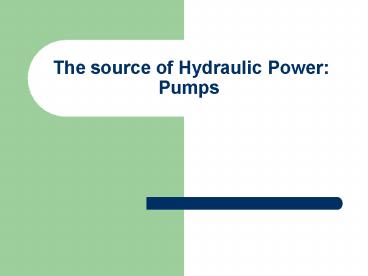The source of Hydraulic Power: Pumps - PowerPoint PPT Presentation
1 / 16
Title:
The source of Hydraulic Power: Pumps
Description:
Hydraulic actuator Linear Hydraulic actuators Single-acting cylinders Double-acting cylinders Cylinder cushions Example 7.2 The source of Hydraulic Power: Pumps ... – PowerPoint PPT presentation
Number of Views:237
Avg rating:3.0/5.0
Title: The source of Hydraulic Power: Pumps
1
The source of Hydraulic Power Pumps
2
Contents
- Introduction
- Pumping theory
- Pump classification
- Gear pumps
- Vane pumps
- Piston pumps
3
Introduction
4
Pumping theory
5
Pump Classification
- Hydrodynamic or non-positive pumps
- They are used for low-pressure, high-volume flow
applications. - Normally their maximum pressure capacity is
limited to 250-300 psi. - Hydrostatic or positive pumps (Gear, vane, piston
pumps) - High pressure capability (up to 10,000 psi or
higher) - Small compact size
- High volumetric efficiency
- Small changes in efficiency
- Great flexibility of performance
6
Gear Pumps
- External gear pumps
- Internal gear pumps
- Lobe pumps
- Screw pumps
7
External gear pumps
For simple systems with a relatively low level of
pressure (about 140 to 180 bar or 14 to 18 MPa)
the gear pump is the most used type of pump.
8
Internal gear pump
9
Vane Pumps
- Unbalanced vane pumps
- Balanced vane pumps
- On many industrial installations with a maximum
pressure of about 200 bar, vane pumps are
applied.
10
Piston pumps
- Axial design
- Radial design
11
Axial piston pumps animation
12
Pump performance
13
Pump selection
- Select the actuator (hydraulic cylinder or motor)
that is appropriate based on the loads
encountered. - Determine the flow-rate requirements. This
involves the calculation of the flow rate
necessary to drive the actuator to move the load
through a specified distance within a given time
limit. - Determine the pump speed and select the prime
mover. - pump type based on the application
- Select the system pressure. This ties in with the
actuator size and the magnitude of the resistive
force produced by the external load on the
system. - Select the reservoir and associated plumbing,
including piping, valving, hydraulic cylinders,
and motors and other miscellaneous components - Calculate the overall cost of the system.
14
Hydraulic actuator
- Linear Hydraulic actuators
- Single-acting cylinders
- Double-acting cylinders
15
Cylinder cushions
16
Example 7.2































